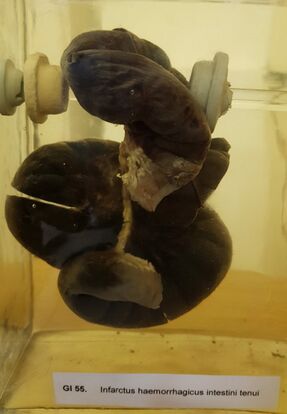4. Haemorrhagic infarct of the small intestine: Difference between revisions
(Created page with "'''Organ''': Small intestine '''Description''': The description is simple. You can see a small part of the small intestine. The infarcted part is blackish and distended, meaning that the diameter of the lumen is increased. '''Diagnosis''': Haemorrhagic infarct of the small intestine '''Causes''': * Thrombus in mesenteric artery * Occlusion of portal vein by thrombus or embolus. * Incarcerated hernia * Volvulus * Invagination * Strangulation '''Theory''': If the po...") |
No edit summary |
||
| (3 intermediate revisions by the same user not shown) | |||
| Line 1: | Line 1: | ||
'''Organ''': Small intestine | '''Organ''': Small intestine | ||
'''Description''': | '''Description''': The description is simple. You can see a small part of the small intestine. The infarcted part is blackish and distended, meaning that the diameter of the lumen is increased. | ||
The description is simple. You can see a small part of the small intestine. The infarcted part is blackish and distended, meaning that the diameter of the lumen is increased. | |||
'''Diagnosis''': Haemorrhagic infarct of the small intestine | '''Diagnosis''': Haemorrhagic infarct of the small intestine | ||
| Line 12: | Line 10: | ||
* Occlusion of portal vein by thrombus or embolus. | * Occlusion of portal vein by thrombus or embolus. | ||
* Incarcerated hernia | * Incarcerated hernia | ||
* Volvulus | * Volvulus or invagination or strangulation of the bowel | ||
'''Theory''': | '''Theory''': | ||
If the portal vein is occluded for any reason, there can theoretically be infarct from the stomach (rare) to and including the superior third of the rectum. | If the portal vein is occluded for any reason, there can theoretically be infarct from the stomach (rare) to and including the superior third of the rectum. The infarct is haemorrhagic because of the rich blood supply of the <abbr>GI</abbr> tract due to its many anastomoses between the two mesenteric arteries. Another contributing cause to who it is haemorrhagic is because there is almost always venous backflow from the portal vein. This backflow can be caused by cardiac failure and any kind of liver disease. | ||
The infarct is haemorrhagic because of the rich blood supply of the <abbr>GI</abbr> tract due to its many anastomoses between the two mesenteric arteries. Another contributing cause to who it is haemorrhagic is because there is almost always venous backflow from the portal vein. This backflow can be caused by cardiac failure and any kind of liver disease. | |||
Bowel infarcts are always haemorrhagic. | Bowel infarcts are always haemorrhagic. | ||
[[File:Haemorrhagic infarct of the small intestine.jpg|center|thumb|Haemorrhagic infarct of the small intestine]] | [[File:Haemorrhagic infarct of the small intestine.jpg|center|thumb|Haemorrhagic infarct of the small intestine|415x415px]] | ||
[[Category:Pathology 1 - Macropreparations]] | [[Category:Pathology 1 - Macropreparations]] | ||
Latest revision as of 10:23, 5 July 2024
Organ: Small intestine
Description: The description is simple. You can see a small part of the small intestine. The infarcted part is blackish and distended, meaning that the diameter of the lumen is increased.
Diagnosis: Haemorrhagic infarct of the small intestine
Causes:
- Thrombus in mesenteric artery
- Occlusion of portal vein by thrombus or embolus.
- Incarcerated hernia
- Volvulus or invagination or strangulation of the bowel
Theory:
If the portal vein is occluded for any reason, there can theoretically be infarct from the stomach (rare) to and including the superior third of the rectum. The infarct is haemorrhagic because of the rich blood supply of the GI tract due to its many anastomoses between the two mesenteric arteries. Another contributing cause to who it is haemorrhagic is because there is almost always venous backflow from the portal vein. This backflow can be caused by cardiac failure and any kind of liver disease.
Bowel infarcts are always haemorrhagic.

